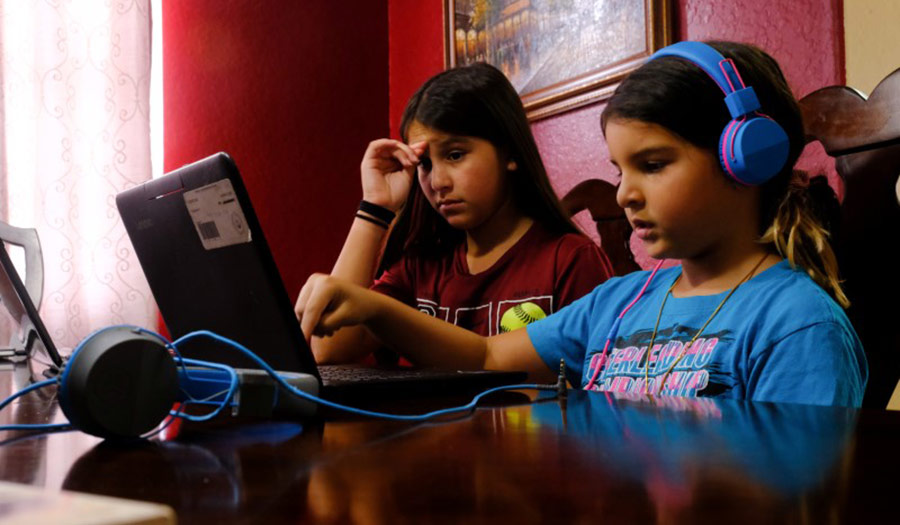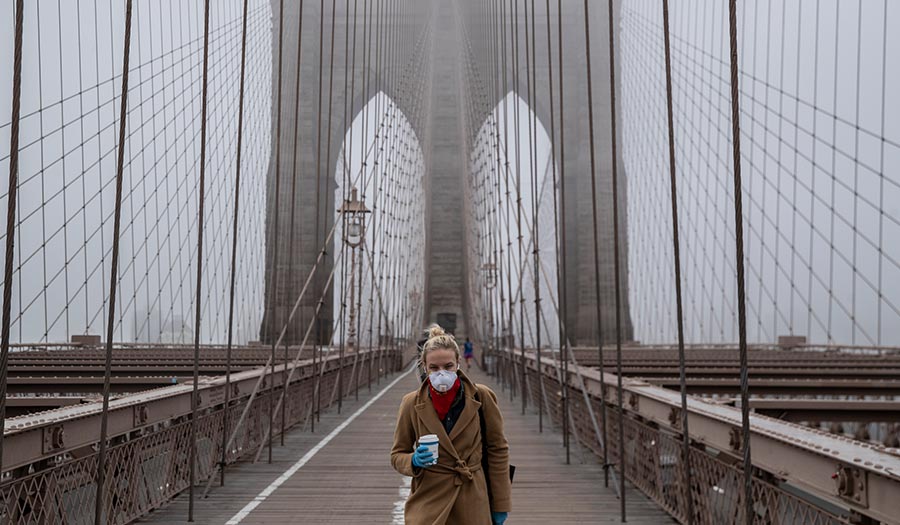 Reuters/Maria Alejandra Cardona
Reuters/Maria Alejandra Cardona
World News Desk
Learn the why behind the headlines.
Subscribe to the Real Truth for FREE news and analysis.
Subscribe NowNEW YORK (Reuters) – Jennifer Panditaratne’s third-grade daughter had been seeing a reading specialist once a week before her Florida school closed abruptly in March due to the novel coronavirus.
Since then, her child has had no contact with the specialist. Mrs. Panditaratne is left to download her daughter’s special education material and sit with her as she does her school work—in between her own calls as a maritime lawyer in South Florida.
“Is it the same material? Sure,” she said. “But is it being administered by a professional who knows what they are doing? No.”
More than two months after schools across the United States began closing in an effort to slow the spread of the coronavirus, the shutdown is taking a profound toll on the nation’s system of education, Reuters found by surveying nearly 60 school districts serving some 2.8 million students.
Almost overnight, public education in the United States has shrunk to a shell of its former self, the review found, with teacher instruction, grading, attendance, special education and meal services for hungry children slashed back or gutted altogether.
The survey encompassed school districts from large urban communities, such as Miami-Dade County Public Schools and the Houston Independent School District, to the smallest rural settings, including San Jon Municipal Schools in eastern New Mexico and Park County School District 6 in Cody, Wyoming. The survey reflects what is happening only in those districts that responded.
Reuters found:
• A large majority of responding districts, 47 of 57, reported they are providing elementary and middle school students with half or less the usual face time with teachers. Eight of those districts said students receive little to no direct instruction. In Philadelphia, tens of thousands of elementary and middle school pupils receive little to no live instruction—and high schoolers receive none at all.
• Fewer than half of districts even take attendance, and many of those that do say fewer kids are showing up for class. Riverbank Unified School District in Stanislaus County, California, no longer takes attendance. But educators there learned through Google Classroom and phone calls that only about half of their 3,000 students are participating in virtual school and completing assignments.
• Public schools play a crucial role in feeding America’s poor children—but the lockdown is gutting that role. About three-quarters of districts reported they served a cumulative 4.5 million fewer meals a week. In Washoe County, Nevada, the school district provided 251,000 meals a week before the shutdown. Since then: Just over 39,000 a week.
• About a third of districts are not providing federally required services to their special-needs students, such as physical and occupational therapy, like they did before schools were closed. “One of the many things keeping me up at night is, how are we providing education to those who most need it?” asked Michael Lubelfeld, superintendent of the North Shore School District 112 outside Chicago.
In the School District of Philadelphia, superintendent William Hite already sees young children falling behind, including those missing critical face-to-face teacher time through the district’s early literacy program. For older students, he worries that the loss of the school structure’s safety net could lead to delinquency and crime.
“This is in no way a sufficient replacement of teacher instruction of students in classrooms,” Mr. Hite said. “I think the impact has already been felt here.”
Several education researchers who reviewed the survey results said that, if anything, the responses likely represent a rosy picture of what is actually happening in the nation’s schools.
Betheny Gross, associate director at the Center on Reinventing Public Education at the University of Washington, believes the results reflected more “optimism” than may be warranted. “This is reflective of what superintendents think is happening,” Ms. Gross said, while the reality may actually be worse.
Ms. Gross cited the high percentage, 84 percent, of districts reporting that at least some students are still receiving at least some live instruction. She said her own review of material posted online detailing what administrators across the country expected instruction to look like during the closure revealed that only a “small share” of districts were setting a standard that included live instruction.
While few children have died from COVID-19, the disease caused by the novel coronavirus, and serious complications for them have been rare, public officials shut down schools to prevent the disease from spreading. Nineteen children under the age of 14 died from COVID-19 from February 1 through May 23, estimates the Centers for Disease Control and Prevention, a figure hovering just above 0 percent of all U.S. virus deaths.
Data on how school closures affect the disease’s spread in the community is limited because the pandemic is still underway. But researchers at University College London found evidence from past epidemics, previous research and modeling of coronavirus transmission in other countries that closing schools has only a slight impact on preventing contagion.
To be sure, public schools, like businesses and governments, were forced into a sudden new world with the pandemic’s spread.
Teachers, parents, researchers and district administrators told Reuters that while distance learning can improve, for the vast majority of students it will fall far short of in-person instruction. If students are not in front of teachers next school year, the public should expect only a fraction of the live instruction, special-needs services going unfulfilled and far fewer meals served.
“I just don’t know how we call off school next year,” said Gregory Cizek, who studies education at the University of North Carolina.
For students, parents and educators, the Reuters survey shows, the loss of live instruction has been significant.
Limited Home Resources
Eliza McCord, 16, was not able to participate in her math class for the first six weeks after her Fort Wayne, Indiana, high school went virtual, because her sister had a college class at the same time. Inside their home, there were not enough devices to go around.
Even now, her family writes a class schedule on a white board. Also in the rotation for devices and WiFi: Her mother, an elementary school special education teacher; her father, a librarian; and her younger brother, in sixth grade.
Many of Eliza’s classmates have told her they do not have regular access to a computer to download files, or reliable access to the internet to join Zoom calls. That said, Eliza thinks some students are not participating because their grades for the final quarter of the year do not count.
“There are students who just have essentially given up on the rest of the school year,” she said.
Charles Cammack, chief operations officer for Fort Wayne Community Schools, said the majority of students remained engaged after schools were closed. Still, he acknowledged that after the system announced grades would not count for the fourth marking period, some students checked out.
“It would be naive to say we didn’t know there was a risk some kids would take that position, but given the circumstances I don’t know how we could avoid that happening,” he said.
In Broward County Public Schools in Florida, where Jennifer Panditaratne’s daughter has not seen a reading specialist since schools closed, the district found not all teacher engagement is equal. Mrs. Panditaratne said her third-grade daughter has a daily 15-minute group Zoom call with her class teacher, going over assignments for the day. Her daughter in fifth grade is getting more live video instruction, but it varies by teacher.
In March, the teacher’s union and district agreed teachers would provide at least three hours a day of deep engagement with students. Many teachers conducted live video instruction, while others used email, phone calls or discussion boards, said Daniel Gohl, the district’s chief academic officer. That left a sense of inequity. So starting this summer, all teachers will provide at least three hours of live-video instruction daily.
“We now know students and teachers need to see and talk to each other,” Mr. Gohl said. “We acknowledge we did not get everything right and we are committed to improving.”
Budget Deficits, Questions Loom
As they look ahead, nearly 70 percent of districts told Reuters they face a budget deficit. The total shortfall of these districts alone exceeds $450 million.
Philadelphia already faces a $38 million deficit, even after receiving federal assistance. With local revenue plummeting, that number could expand in the weeks to come.
Many school districts are now confronting a question most on the minds of parents: Will they reopen schools in the fall, or continue the distance learning?
Dan Domenech, executive director of AASA The School Superintendents Association, a group representing school district chiefs, meets every week with a task force on reopening consisting of 30 superintendents from across the country.
Three options are being considered for the fall, he said: fully reopening schools as they were prior to the pandemic; a hybrid model in which some students attend school in-person and some continue with remote learning; and continuing with complete remote learning.
The hybrid option, Mr. Domenech said, appears to have the most support. But staying entirely remote, he added, is “beginning to get some traction because the cost of opening schools and following the guidance the CDC has offered is going to be cost prohibitive.” The added costs include more buses to maintain social distancing, protective equipment for students and staff and the daily cleaning of each school.
As districts weigh that question, some parents and teachers worry what comes next.
Portia Hudson, a math teacher at Edwin Fitler Academics Plus School in the Germantown neighborhood of Philadelphia, recalls teaching virtually this spring and watching one student, already battling anxiety problems, fall five weeks behind. During another session, a second student played on a swing during class time.
“If we have virtual learning in September, that’s when I’m really going to be concerned, because virtual learning will look like it does now,” Ms. Hudson said. “Kids not logging on. Kids on swings.”
- Real Truth Magazine Articles
- SOCIETY & LIFESTYLES
 COVID-19: The New Normal?
COVID-19: The New Normal?
More on Related Topics:
- The Education Department Is Dismantling. Here’s What That Means
- Some States Now Require Public Schools to Teach Kids About Gun Safety
- The Rise of AI Tools Forces Schools to Reconsider What Counts as Cheating
- The U.S. Academic Partnership with China, Under Strain for Years, Faces Its Biggest Threat
- Half of U.S. States Now Have Laws Banning or Regulating Cellphones in Schools, with More to Follow


